Dunmanway, Co. Cork
Dunmanway Poor Law Union was formally declared on the 18th December 1839 and covered an area of 140 square miles. Its operation was overseen by an elected Board of Guardians, 15 in number, representing its 7 electoral divisions as listed below (figures in brackets indicate numbers of Guardians if more than one):
Co. Cork: Ballymoney (2), Drinagh, Dunmanway (4), Inchageela (2), Kilmeen (2), Kilmicael (3), Kilmurry.
The Board also included 5 ex-officio Guardians, making a total of 20. The Guardians met each week on Saturday.
The population falling within the Union at the 1831 census had been 30,138 with divisions ranging in size from Kilmurry (population 1,473) to Dunmanway itself (11,405).
The new Dunmanway Union workhouse was erected in 1840-1 on a five-acre site a mile and a half to the north-east of Dunmanway. Designed by the Poor Law Commissioners' architect George Wilkinson, the building was based on one of his standard plans to accommodate 400 inmates. Its construction cost £5,210 plus £990 for fittings etc. The workhouse was declared fit for the reception of paupers on 16th September 1841, and received its first admissions on 2nd October. The site location and layout are shown on the 1841 map below.
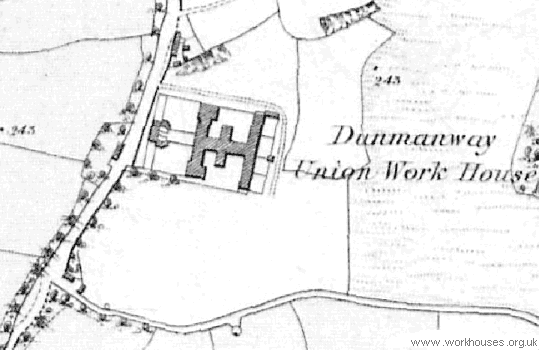
Dunmanway workhouse site, 1841.
The buildings followed Wilkinson's typical layout. An entrance and administrative block at the east contained a porter's room and waiting room at the centre with the Guardians' board room on the first floor above.
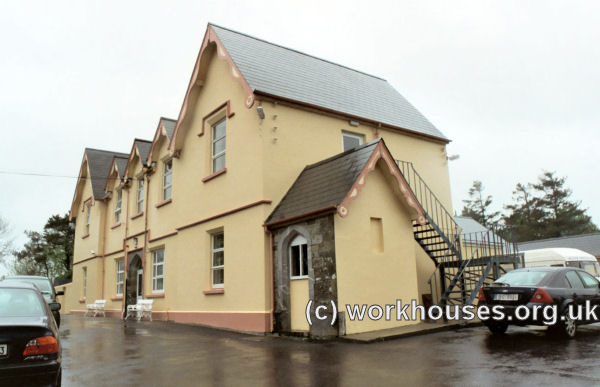
Dunmanway former workhouse entrance and administrative block from the south-west, 2002
© Peter Higginbotham.
The main accommodation block had the Master's quarters at the centre, with male and female wings to each side. At the rear, a range of single-storey utility rooms such as bakehouse and washhouse connected through to the infirmary and idiots' wards via a central spine containing the chapel and dining-hall.
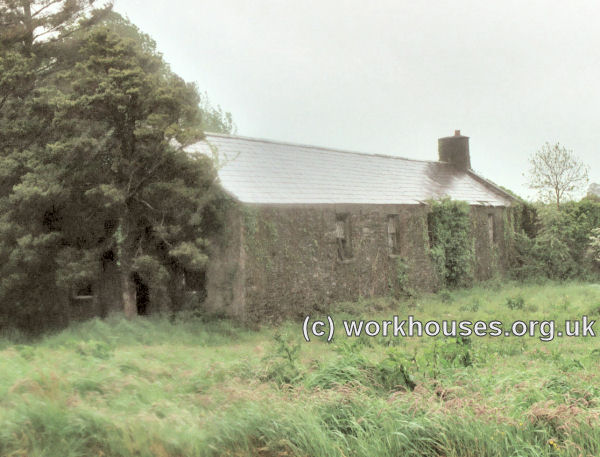
Dunmanway workhouse central spine from the west, 2002
© Peter Higginbotham.
During the famine in the mid-1840s, a house was hired and stable sheds were appropriated to accommodate 120 extra inmates. A fever hospital to accommodate 60 patients was erected at the north of the workhouse. The later layout of the site is shown on the 1900 map below.
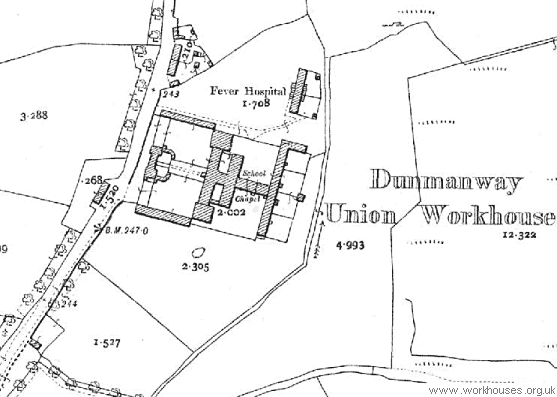
Dunmanway workhouse site, 1900.
The minutes of the Board of Guardians meeting on Saturday 10th July 1847 record:
In April 1884, one of the Guardians, Mr Hurley, proposed that the workhouse diet be improved. to include meat four times a year and fish once a month. However, no-one seconded the resolution so it received no further consideration.
In 1895, Dunmanway was visited by a "commission" from the British Medical Journal investigating conditions in Irish workhouse infirmaries. Their report described the nursing arrangements at Dunmanway as "a travesty" and the wards as "quite unsuitable" for their purpose. They also pleaded for some basic comforts for the aged, armchairs, better heating and lighting in the wards, and improved sanitary facilities — there were no indoor toilets, just "soil pails" which left uncovered and unemptied during the night. Further details are available in the full report.
On the night of 11-12 December 1920, the British Auxiliary Force's 'K' Company, then based in Cork, went on a massive rampage in the city, burning and looting buildings and attacking local people. The 'Burning of Cork', as it became known, was carried out in reprisal for the ambush of a Company patrol by the Irish Republican Army in the city, in which twelve Auxiliaries were wounded, one fatally. Shortly after the event, 'K' Company were moved to new quarters at Dunmanway workhouse. The master of the institution at that date was Timothy Burke, the great-grand-uncle of former Taoiseach, Bertie Ahern. Ahern learned about his connection to the workhouse when he visited the site in 2018 for his appearance in the Irish version of the TV show Who Do You Think You Are?
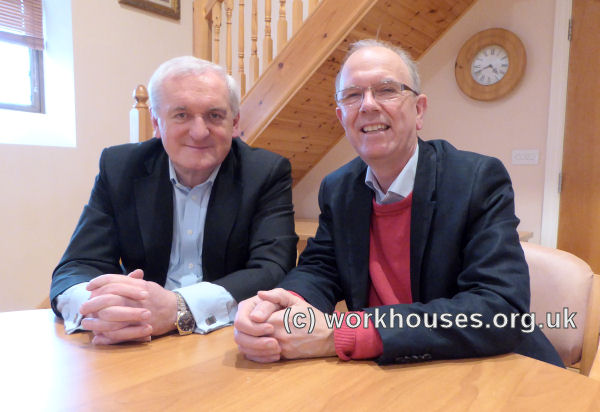
Bertie Ahern with Peter Higginbotham for Who Do You Think You Are?, 2018
© Peter Higginbotham.
After the creation of the Irish Free State in 1922, the workhouse fever hospital was redesignated as a District Hospital, with a scheme to use the workhouse entrance block as a cottage hospital. In 1927, the workhouse buildings were described as being in a bad state of repair, with no proper water supply, water closets, or bathing accommodation.
The former workhouse site is now (2002) the home of St Anthony's Hospital. Only the entrance block and the chapel/dining-hall survive from the original buildings. After a period of standing derelict, the latter has now been renovated for local community use.
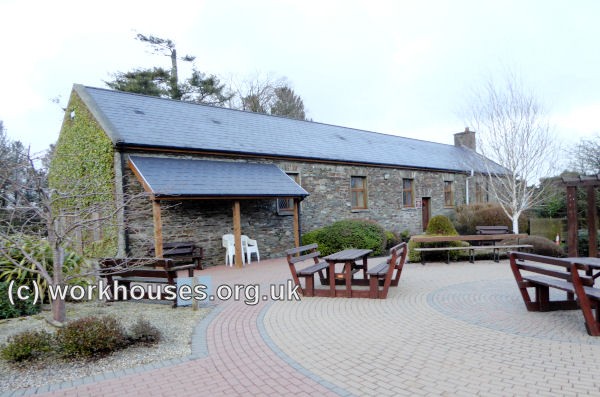
Dunmanway workhouse central spine from the west, 2002
© Peter Higginbotham.
At the rear of the building, part of the original front wall of the infirmary block also survives.
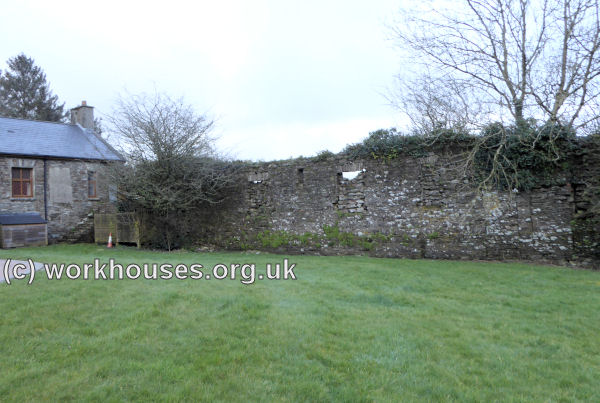
Dunmanway workhouse infirmary wall, 2018
© Peter Higginbotham.
Records
Note: many repositories impose a closure period of up to 100 years for records identifying individuals. Before travelling a long distance, always check that the records you want to consult will be available.
- Cork City and County Archives, 33a Great William O'Brien Street, Blackpool, Cork. Holdings include: Board of Guardian Minute Books (1840-1920).
Bibliography
- Crossman, V (2006) Politics, Pauperism and Power in Late Nineteenth-century Ireland
- Gray, P (2009) The Making of the Irish Poor Law, 1815-43
- O'Connor, J (1995) The Workhouses of Ireland
Links
- None.
Unless otherwise indicated, this page () is copyright Peter Higginbotham. Contents may not be reproduced without permission.


